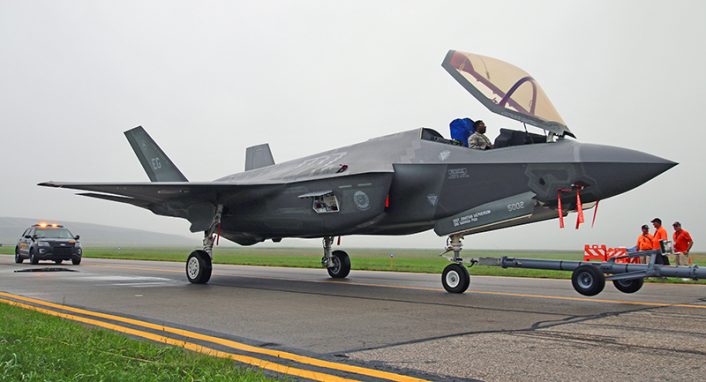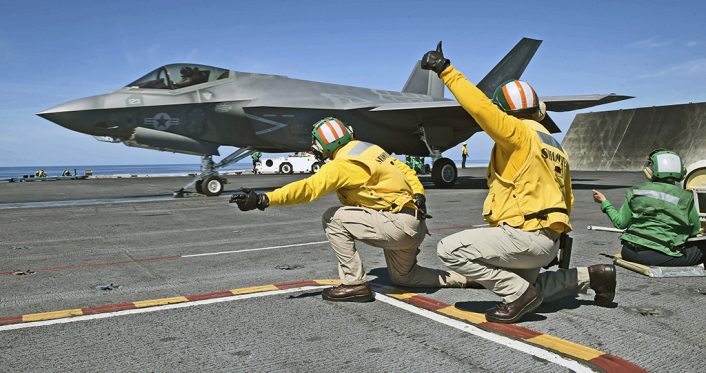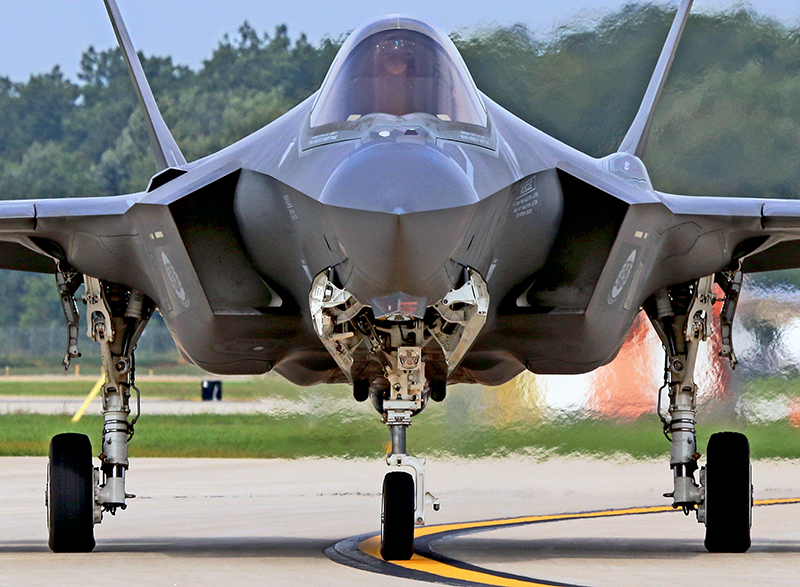Joint Strike Fighter is Still a Lightning Rod of Criticism, But Progress Continues.
The F-35 Joint Strike Fighter program reached several developmental milestones in August 2018 despite ongoing criticism of the program’s costs and reported technical concerns. As the effort to integrate the weapons system into participating air forces accelerates, the obstacles and challenges faced by the F-35 begin to appear more economic and political, and less practical and technical.
The airplane is beginning to work mostly as advertised, with the U.S. Air Force leading the integration into the force structure within the United States. The Navy and Marines continue to resolve technical challenges as their F-35 integration progresses, even though a recent POGO investigation has exposed that “program officials are recategorizing – rather than fixing – some of the aircraft’s design flaws, likely in an attempt to keep the from blowing through another deadline and budget cap.”
The U.S. Air Force is currently investigating the cause of last week’s nose gear collapse at Eglin Air Foce Base, while the Navy has begun to moderate the causes of the nose wheel oscillating vertically during catapult launches at some aircraft weights. The Navy is also working to resolve a helmet visibility problem that compromises the pilot’s view of aircraft carrier’s landing light systems at night. Until the solution is achieved for the F-35C, night landings at sea are restricted to experienced pilots. The Marines have asked for special lightning rods to prevent their recently deployed aircraft from being struck by lightning on the ground, a problem that could damage aircraft electronics. Some foreign F-35 operators will have the ability to block the F-35’s systems from sending data back to the U.S. through the Sovereign Data Management (SDM) system. This will create a sort-of operational security firewall for the much criticised Autonomic Logistics Information System (ALIS).
Perhaps the most adversarial environment for the F-35 is not denied airspace over Syria or Iran. The real high-threat environment for F-35 seems to be the no-rules, asymmetrical battlespace of social media.
In the late 1950s and ‘60s when the North American F-100 Super Sabre and Republic F-105 Thunderchief multi-role combat aircraft were in development major accidents were frequent. During the early testing and integration of the first production supersonic fighter, the F-100 Super Sabre, one aircraft was lost or damaged nearly every three days. The F-100’s own chief test pilot, North American’s George Welch, died in a 1954 crash.
Nearly half of the Republic F-105s were lost by the end of the Vietnam conflict, most to enemy action, but some in accidents before the aircraft ever deployed. Some of the F-105 accidents were high profile even before social media. One F-105 broke in two during use by the Air Force Thunderbirds. Another F-105 crashed in a Las Vegas neighborhood on May 13, 1964, killing three children and a woman on the ground along with the pilot. Eight houses burned in the crash. The F-105 was grounded pending safety investigations that revealed several dangerous problems that were subsequently repaired.
Acknowledging that the F-100 and F-105, along with the F-104 Starfighter, were among the first to fly at supersonic speeds, their technological progression from the previous generation aircraft, the P-80 Shooting Star and F-86 Sabre, could be regarded as similar to the differences between modern F-15s and F-16s and the F-35 Joint Strike Fighter.
While there are ongoing problems with the F-35, these could be characterized as lesser than the potential context of the entire program and the arc of advancement in its key technologies. A primary challenge facing the overall F-35 program is not the technology of the aircraft itself, but the inability of the public to grasp what the F-35 actually will do. It is like trying to convince the owner of a $40 rotary telephone that a $700 iPhone is worth the upgrade, especially when they learn the battery can die and render the phone inoperable.
Integrating the F-35 into a modern and evolving battlespace has been as much a public affairs and perception challenge in the social media age as the technical challenges the program faces.
The debate between F-35 supporters and critics escalated in July 2015, when War Is Boring obtained a brief that claimed the F-35 Joint Strike Fighter was outclassed by a two-seat F-16D Block 40 (one of the aircraft the U.S. Air Force intends to replace with the Lightning II) in mock aerial combat.
TheAviationist.com researched and debunked some theories about the alleged capabilities of each F-35 variant to match or considerably exceed the maneuvering performance of some of the most famous fourth-generation fighters. Our analysis also also made a strong case that there is probably no way a JSF will ever match a Eurofighter Typhoon in aerial combat. Our editors also highlighted that the simulated dogfight mentioned in the unclassified report obtained by War Is Boring involved one of the very first F-35 test aircraft that lacked more recent upgrades in currently fielded F-35s.
In March 2016, we published an article written by Major Morten “Dolby” Hanche, an experienced Royal Norwegian Air Force tactical pilot with more than 2,200 hours in the F-16. Major Dolby is also a U.S. Navy Test Pilot School graduate and the first Norwegian pilot to fly the F-35. In that post “Dolby” provided a first-hand account of what dogfighting in the controversial F-35 looked like to a pilot who had a significant experience in the F-16 along with formal experience as a flight test and analysis pilot.

At the first Red Flag combat simulation exercise the F-35 participated in during early 2017 reports claimed the aircraft achieved a “15 to 1” kill ratio. But one noted journalist, Tyler Rogoway of “The Warzone”, wrote:
“The 15:1 kill ratio in particular is nebulous, because it seems this may be skewed in terms of what data it actually includes. Kill ratios attributed to a platform naturally make us think of direct engagements with enemy aircraft, but Red Flag is a highly integrated air battle, one that always uses the latest data-link fusing gateways and other force-multipliers. It remains unclear whether the stated kill ratio is strictly attributable to the F-35, or if it includes the actions of other coalition aircraft, particularly F-22s, while the F-35 is merely present.”
Rogoway’s insight into the “15 to 1 kill ratio” highlights the traditional air combat paradigm that, if a missile didn’t fly off an aircraft’s wing, that aircraft didn’t score the kill. But the F-35 doesn’t work that way. A key F-35 technology is sensor fusion. Sensor fusion is pulling in targeting data from sensors on other platforms such as surveillance aircraft or shipborne surface radars. The F-35 can then “hand-off” targets to other weapons platforms, effectively scoring a kill that would not have otherwise happened, but without firing a shot itself.
This is what TheAviationist.com’s Chief Editor David Cenciotti wrote back then:
Well, after eight days “at war”, in spite of being “just” IOC (Initial Operational Capable – the FOC is expected next year with Block 3F) the F-35A Lightning II is proving to be an “invaluable asset” during Red Flag 17-01, the Air Force’s premier air combat exercise held at Nellis Air Force Base, Nevada: its ability to gather, fuse, and distribute more information than any other fighter in history provide the pilot with vital situational awareness that can be exploited to escape (and engage?) highly sophisticated and lethal enemy ground threats and interceptors.
Actually, the extent of the F-22 Raptors contribution to the above mentioned kill ratio is not clear: the F-35s are flying alongside Raptors and, as one might expect, the F-22s take care of the aggressors whilst the F-35s slip undetected through the surface-to-air defenses until it reaches the position to drop munitions at the target.
Considered that the F-22s are providing air cover to the Lightning IIs, is the 15:1 score a team result or the actual kill ratio of the F-35A?
There’s been much debate about the kill ratio of the F-35 made public after air-to-air engagements against other aircraft (namely the F-15E during a similated deployment last year).
In other (F-35) news…
Diplomatic wrangling surrounding the program has created the most sensational turbulence, and one significant stall in the case of the delayed Turkish program deliveries. The first Turkish pilot to fly an F-35A Lightning II, Major Halit Oktay, flew the aircraft at Luke AFB near Phoenix, Arizona on August 28, 2018. The Turkish news outlet “Daily Sabah” reported the flight on Wednesday.
A report also surfaced this week that the U.S. was trying to convince Turkey to “Give Up S-400s and Get F-35s” according to a headline on the HurriyetDailyNews.com Turkish news outlet. The U.S. has voiced security concerns about Turkey employing both Russian designed S-400 surface-to-air missile systems and the F-35A Joint Strike Fighter. The concerns have resulted in a delay in providing F-35As to Turkey even as the U.S. continues to train Turkish F-35 pilots at Luke AFB. The S-400 missile system is claimed to have “anti-stealth” capabilities that could pose a threat to the F-35. U.S. lawmakers are concerned that one country using both weapons systems may compromise the security of some aspects of the F-35 program.
The U.S. Navy also achieved an F-35 milestone this week when the first F-35C integrated flight operations were conducted from the aircraft carrier USS Abraham Lincoln (CVN-72). It was the first time U.S. Navy F-35C Lightning IIs operated as an integrated part of a carrier-launched strike package. F-35Cs from Strike Fighter Squadron (VFA) 125, the “Rough Raiders”, from Naval Air Station Lemoore conducted their Operational Test-1 (OT-1) with Carrier Air Wing (CVW) 7 and Carrier Strike Group 12 aboard the Nimitz-class aircraft carrier USS Abraham Lincoln. The unique, wide-winged Navy F-35Cs flew in coordination with F/A-18s and other aircraft while integrating with a navy air wing conducting cyclic missions.

ATLANTIC OCEAN (Aug. 20, 2018) An F-35C Lightning II from the Rough Raiders of Strike Fighter Squadron (VFA) 125 prepares to launch from the flight deck of the Nimitz-class aircraft carrier USS Abraham Lincoln (CVN 72). (U.S. Navy photo by Mass Communication Specialist 1st Class Brian M. Wilbur/Released)
The Italian Air Force, quite “shy” about its most advanced aircraft, is sending one of their F-35As to take part in the first European airshow at Belgian Kleine-Brogel Air Base on Sept. 8-9.
Looks like the @ItalianAirForce @thef35 will make their European airshow debut at Belgian @AirForceDays on Sept. 8 – 9. At least one took part at @LukeAFB Luke Days 2018 in March this year (but it doesn’t count as it was one those based there). pic.twitter.com/5YL01MhUE1
— David Cenciotti (@cencio4) August 29, 2018
Other upcoming milestones in the F-35 program will include the first flights of the British F-35s from their new aircraft carrier, the HMS Queen Elizabeth, scheduled for early next year off the U.S. coast. The tests will initially use U.S. aircraft but likely be flown by British pilots. Meanwhile, the British have carried out the first trials out of Edwards Air Force Base, California, carrying UK-built ASRAAM missiles.
British jet? ✅
British pilot? ✅
British weapons? ✅#F35 flight ‘a symbol of the major part we are playing in what is the world’s biggest ever defence programme’, Defence Minister announces.
Read more: https://t.co/cVtkrRAX5I 🇬🇧🌎 @thef35 pic.twitter.com/gyPbwUHuav
— Ministry of Defence 🇬🇧 (@DefenceHQ) August 30, 2018
On the other side, it’s a bit of a mystery why the F-35 that have arrived to the UK haven’t flown in over a month as reported by Aviation Week. According to the MoD this was caused by maintenance checks as well as personnel leave and will have no impact on achieving the IOC (Initial Operational Capability) in December…
While the F-35 program has received valid criticism over its cost the program is showing signs of providing economic returns. Lockheed Martin stock has climbed from $122.42 per share five years ago to its Wednesday close of $321.29. The stock has lead the defense financial sector with a five year increase of 89.63% while returning a dividend yield of 2.5%. Lockheed Martin also honored a commitment to hire 1,800 new employees for the F-35 Lightning II Joint Strike Fighter program.
The recent milestones in the overall F-35 Joint Strike Fighter program are important to consider set the against the backdrop of publicized problems within the program. While many of the concerns facing the F-35 development are valid and significant, according to all the analysts and pilots we have talked to, they could be characterized as “the new normal” for a program as vast as the Joint Strike Fighter. For this reason, as long as the current trend of developmental advances in the program begin to outpace the ongoing concerns over costs and technical evolution, the F-35 Joint Strike Fighter program will likely emerge as a net gain in a technical space where there is no second place.









